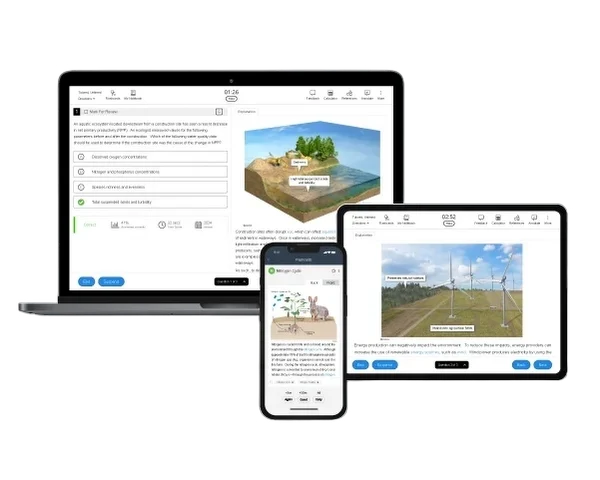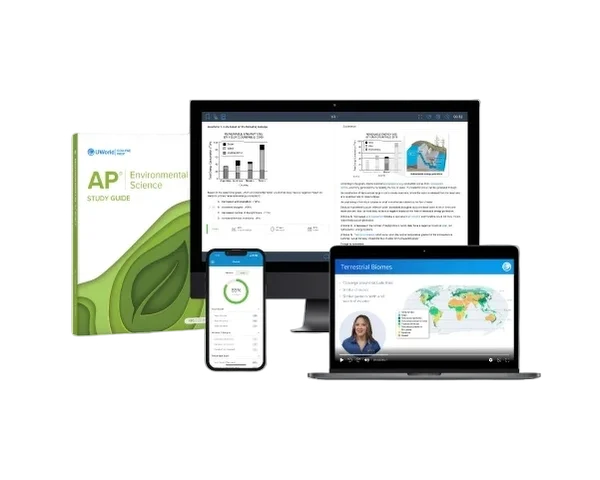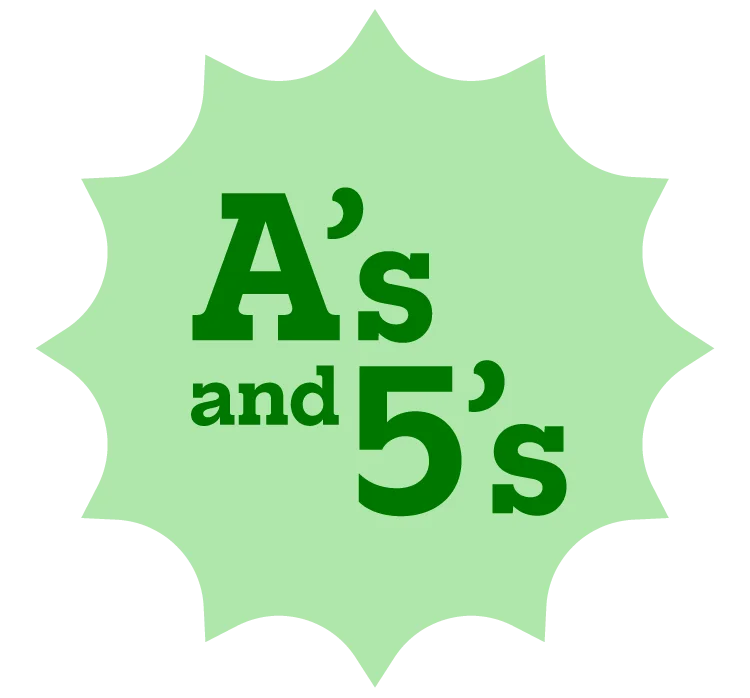The AP® Environmental Science (APES) exam does not provide an equation sheet, so it's essential to have a solid understanding of chemical formulas and mathematical routines to confidently tackle both the multiple-choice (MCQ) and free-response questions (FRQ).
AP Environmental Science Formula Sheet
While there isn't a formal AP Environmental Science sheet with equations and formulas, we've compiled a list of chemical formulas and mathematical routines that will help you score well on the AP Environmental Science exam.
The application of mathematical routines is known as Science Practice 61 from the Course and Exam Description (CED). It makes up:
- 6-9% of the MCQ section
- 20% of the FRQ section
To get full credit on the FRQ section, you will be required to show your work when performing calculations, including proper unit labeling.
Our AP Environmental Science Online Course provides in-depth learning tools, expert explanations, and practice questions to master these formulas.
APES Chemical Formulas
Here are important chemical APES formulas to know:
| Common Name | Chemical Equation |
|---|---|
| Respiration | C6H12O6 + 6O2 → 6CO2 + 6H2O |
| Combustion | Hydrocarbons (CxHy) + O2 → CO2 + H2O |
| Photosynthesis | 6CO2 + 6H2O + sunlight → C6H12O6 + 6O2 |
| Ocean acidification | CO2 + H2O ↔ H2CO3 ↔ H+ + HCO3- |
| Photochemical smog formation | NOx + VOCs + heat + sunlight → smog |
| Stratospheric ozone depletion | O3 + Cl → O2 + ClO |
List of Mathematical Routines
Here are the important mathematical routines:
| Common Name | Mathematical Formula |
|---|---|
| Population density | Population / Area |
| Rule of 70 | 70 / Percent growth rate |
| Population growth rate as a percent | Births - Deaths / Number of people x 100 |
| Rate of change | Final - Initial / Final time - Initial time |
| Percent change | Final -Initial / Initial x 100 |
| Net Primary Productivity (NPP) | Gross primary productivity (GPP) - Respiration |
| Gross Primary Productivity (GPP) |
GPP = Rate of photosynthesis by plants
GPP can also be expressed as: GPP = Total solar energy captured by plants − Energy lost due to respiration by plants |
| Fuel efficiency | Distance traveled / Unit of fuel consumed |
| The 10% Rule | The 10% rule states that roughly only 10% of energy transfers between trophic levels in a food chain, with the rest being lost as heat. |
| Dimensional Analysis | Quantity 1 x Conversion factor / Quantity 2 = Result |
| Half-Life | t½ = ln (2) / λ |
| LD50 | LD50 = Dose / Weight |
Our AP Environmental Science Study Guide, available in print and digital formats, provides step-by-step solutions and real-world applications to help you master calculations with ease.
15 Tips on How to Use APES Formulas on the Exam
Here are some tips for effectively using formulas on the AP Environmental Science exam:
- Show All Work: Always show your work when performing calculations, even if they seem simple. This can help you understand and review your process. Don't forget to include units in your calculations.
- Develop Math Sense: Make sure your answers make sense. If a calculation produces an answer of $50 billion per gallon of water, it's likely incorrect. Trust your intuition while checking your answers.
- Know Conversions: Be familiar with common conversion factors, including the number of days in a year and hours in a day.
- Metric Prefixes: Understand and convert metric prefixes, from tera to nano. This knowledge will help you work with various units in scientific calculations.
- Handle Negative Numbers: Be comfortable with negative numbers and understand how they affect calculations. For instance, going from -8°C to +2°C represents a 10°C change.
- Understand Rates: Recognize the various ways to calculate rates and understand that they are about how something changes over time. "Per" means division, so miles per gallon is miles driven divided by 1 gallon.
- Use Dimensional Analysis: Use dimensional analysis to perform unit conversions. This method helps maintain the consistency of units in your calculations.
- Calculate Percentage and Percent Change: Know how to calculate percentages and percent changes. Understand that a percentage is a measure of a part divided by the whole, and percent change can be calculated using the given formula.
- Calculate Population Growth Rate and Density: Learn how to calculate population growth rates and population density. Additionally, remember key population figures such as the U.S. and world populations are important in scientific notation.
- Know the Rule of 70: Use the Rule of 70 to predict doubling times based on the annual growth rate. This is necessary for understanding population dynamics.
- Recognize Exponential Growth: Understand the formulas for exponential growth, which are important for studying population trends.
- Calculate Half-Life: Know how to calculate half-life for different elements and substances. The formula helps estimate decay rates.
- Calculate pH: Use the formula -log [H+] to find pH values. Remember that pH measures the concentration of hydrogen ions and how each 1-point change corresponds to a tenfold difference in concentration.
- Recognize Units of Energy and Power: Familiarize yourself with units of energy and power, such as watts, calories, BTUs, kilowatt hours, and efficiency.
- Label Graphs: When graphing, label each axis with units, use consistent scale increments, connect the data points, interpolate, extrapolate, add a title and key, and practice creating graphs by hand.
By following these tips and utilizing the needed resources, you can master the AP Environmental Science formulas and confidently approach the exam. Remember, practice is key! The more you work with these formulas, the more comfortable you will become applying them to solve environmental science problems.

Memorizing APES Math Formulas
To memorize and retain APES equations, create flashcards and review them regularly. Use the AP Environmental Science formula sheet for quick reference. Mnemonic devices make for easier recall. Teaching someone else the formulas can also reinforce your understanding.
Additionally, utilize online practice resources such as UWorld's study tools with detailed answer explanations to help you grasp and retain each of the formulas.
Which APES Formula Should I Use?
To determine the right AP Environmental Science formula and apply it effectively, carefully read the question, looking for keywords and specific information. Highlight or underline data to help you determine what's being asked. Pay attention to units, as they often point to the right formula.
Additionally, you'll need to consider the problem's context — whether it's related to population dynamics, energy, or chemistry. Systematically solve the problem by writing down known values, identifying the unknown, and applying your chosen formula. Practicing realistic APES exam questions with quality learning tools, such as UWorld's AP Environmental Science practice test, can help you become familiar with how to apply each formula.
Don't be afraid to use the process of elimination. Label your work, including units, and review it.
Frequently Asked Questions (FAQs)
Is there an official formula sheet for AP Environmental Science?
No. There isn’t an official APES formula sheet for the exam.
Do you get an AP Environmental Science equation sheet for the APES exam?
No. You will not get an AP Environmental Science equation sheet to take the exam.
What formulas do I need to know for the APES exam?
The following is a list of AP Environmental Science equations and formulas you need to memorize:
| Common names of Equations | Common names of Formulas |
|---|---|
| Respiration | Population Density |
| Combustion | Rule of 70 |
| Photosynthesis | Population Growth Rate as a Percent |
| Ocean Acidification | Rate of Change |
| Photochemical Smog Formation | Percent Change |
| Stratospheric Ozone Depletion | Net Primary Productivity (NPP) |
| Gross Primary Productivity (GPP) | |
| Fuel Efficiency | |
| The 10% Rule | |
| Dimensional Analysis | |
| Half-Life | |
| LD50 |
References
- (2020). Science Practices. Course Framework. AP® Environmental Science COURSE AND EXAM DESCRIPTION. Retrieved on December 18, 2024 from https://apcentral.collegeboard.org/media/pdf/ap-environmental-science-course-and-exam-description.pdf
- (2024). AP Environmental Science Exam Tips. AP Environmental Science Exam. College Board. Retrieved on December 18, 2024 from https://apstudents.collegeboard.org/courses/ap-environmental-science/exam-tips

Read More About AP Environmental Science
A simple course and exam description can help you spend less time studying. Here is our simple-to-read AP Environmental Science CED that explains units, topics, and concepts in detail.
AP Environmental Science Study PlanStop wasting time trying to find the perfect study plan and guide. This complete AP Environmental Science study plan includes all tested techniques and resources to help you earn a 5.
AP Environmental Science Score GuideCrunch some numbers with our AP Environmental Science Scoring Guide, which provides you with score distribution information and important rubrics to help you project your score.
Best AP Environmental Science Course ReviewFind the top AP Environmental Science courses with our in-depth reviews. Compare options, explore key features, and choose the best course to boost your score.
AP Environmental Science Study Guide ComparisonCompare the best AP Environmental Science study guides to find the right fit for you. See key features, strengths, and expert insights to help you choose wisely.
How to Self-Study for AP Environmental ScienceLearn how to self-study for AP Environmental Science with expert tips, study plans, and essential resources to help you stay on track and ace the exam.




